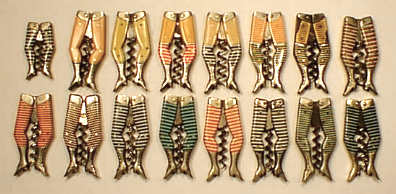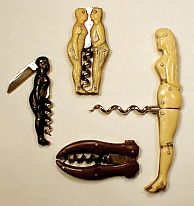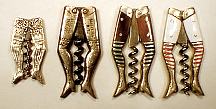 |
| Celluloid was the first synthetic plastic
material. In 1856 it was synthesized by British Chemist Alexander Parkes
(1831-1890). John Wesley Hyatt (1837-1920) of Starkey New York developed it as
a commercial product in 1869. Celluloid is produced from a mixture of cellulose
nitrate and camphor. It is a strong, durable product which can be produced in
many colors. It was even an expensive substitue for ivory. Common products made
from celluloid include combs, brushes, dentures, billiard balls, photographic
film and, yes, scales for figural corkscrews! Here are a few of the corkscrews with celluloid scales in the shapes of legs, mermaids, alligators, kissing couples and shoes. Marks and patent data are noted. Manufacturers marks noted are detailed at the bottom of this page. |
 |
| The gay nineties legs are German patent 21718
issued to Steinfeld & Reimer January 1, 1894. Mini legs are the hardest of the celluloid legs to find. The pair at top left is 1 7/8" long. This is followed by a rare bare flesh tone. The second from the top right has two different stripe pairings on each side. Markings on legs include: GERMANY; GESETZLICH GESCHÜTZT; SRD (with arrow through it) GERMANY; MORLEY & SONS GERMANY; HUGO KÖLLER SOLINGEN; REGISTERED GERMANY; GRAEF & SCHMIDT MADE IN GERMANY; HENRY BOKER; LUNAWERK SOLINGEN GERMANY; D PERES GERMANY. The most common color stripes for legs are pink / white, green / white and blue /white. However, the pink / white at bottom center is very unusual in that it carries advertising on the shank: VAL BLATZ BR'G CO. MADE IN GERMANY. |
 |
| Top: Marked AMOR GERMANY, D.R.G.M. 105407. The
German Patent was issued to Carl Bewer of Solingen on November 31, 1898. This
corkscrew is sometimes referred to as the "Kissing Couple" and also
was produced with all metal scales. Left: Blade marked A ANDERSON, ESKILSTUNA. An Anderson advertisement calls this "svart celluloidskaft" - black celluloid. It has at times been misidentified as Bakelite. Bakelite is a thermosetting plastic resin invented by Leo Hendrik Baekeland (1863-1944) in 1909. He was a U.S. chemist and inventor born in Ghent, Belgium. Right: The woman folds in the middle and is marked GES. GESCH. Bottom: The shoes are Ernst Lesser's German Patent number 82028 of September 4, 1897. Marked WEYERSBERG & SON GERMANY |
 |
| Mermaids from Left to Right: 1. Marked SRD (with arrow through it) and GERMANY on neckstand. Can opener blade on backside. 2. Marked GES GESCHÜTZT on neckstand. Reddish brown. Foil cutter on backside. Also reported marked simply SOUVENIR. 3, Marked F. WESTPFAL GERMANY on neckstand. Ivory color. Foil cutter. 4. Unmarked two color with foil cutter. 5. Marked GESETZLICH GESCHÜTZT GERMANY on neckstand. Two color. No blade on backside. Unusual web helix. 6. Marked GRAEF & SCHMIDT GERMANY on rare knife blade type. Foil cutter and fluted helix. Although a Mermaid has been reported with the markings GERMANY PAT APPL FOR, I do not know if a patent was issued. |
 |
| 1 & 2: Neckstand marked GESETZLICH
GESCHÜTZT GERMANY. Both have foil cutter blade. 3. Neckstand marked W. H. MORLEY & SON, GERMANY. Can opener blade on back side. 4. Neckstand marked GESETZLICH GESCHÜTZT GERMANY. No Blade on backside. |
 |
| Non-celluloid legs from Left to
Right: 1. Mini legs. The top of the worm is marked REGISTERED GERMANY. The silver scales are marked STERLING. 2. All metal scales advertising LOERZEL BROTHERS, SAUGERTIES, N.Y., CELEBRATED LAGER 3 & 4. 1970's productions marked GERMANY. Plastic thighs and stripes are painted in the grooves. |
Companies and marks in this study:
|
©1997 Donald A. Bull